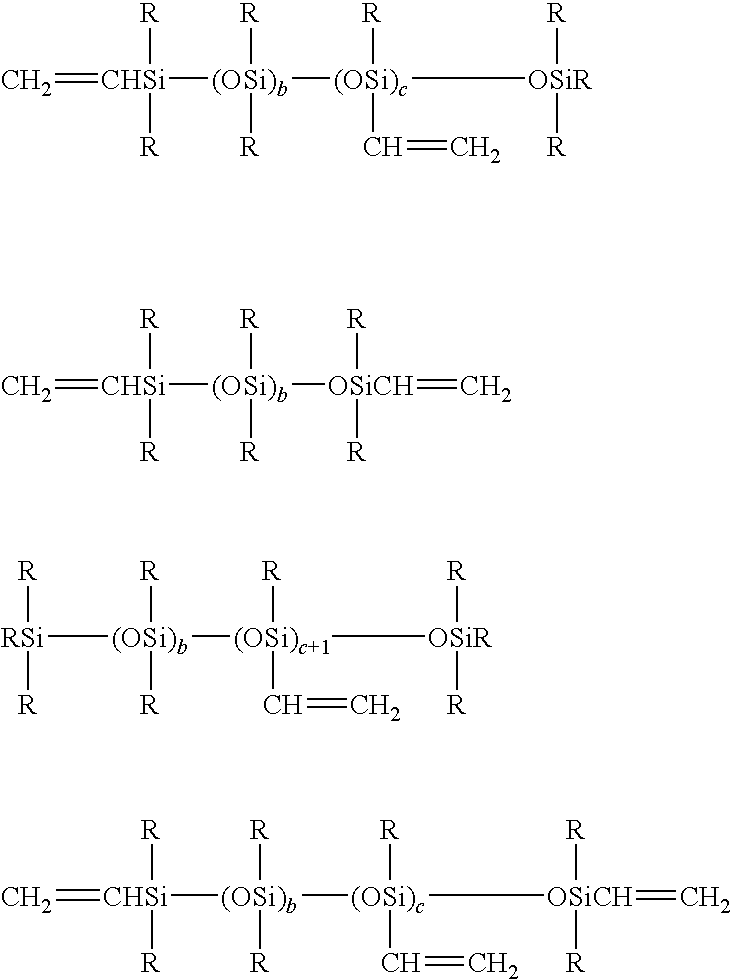Method of producing metal-ceramic composite material having metallic luster
- Summary
- Abstract
- Description
- Claims
- Application Information
AI Technical Summary
Benefits of technology
Problems solved by technology
Method used
Image
Examples
example 1
[0091]The compounds (A) and (B) shown below were used as silicone components, the complex (C) described below was used as a platinum group metal-based catalyst, and the material (D) was used as the metal filler. The quantity of each component is also shown below.
(A) 55 parts by mass of a diorganopolysiloxane containing vinyl groups within each molecule and represented by an average composition formula shown below:
(wherein, the molar ratio of alkenyl groups relative to all the silicon atoms within the molecule is 0.688),
(B) 45 parts by mass of a diorganopolysiloxane containing hydrogen atoms bonded to silicon atoms and represented by an average composition formula shown below:
(wherein, the molar ratio of SiH groups relative to all the silicon atoms within the molecule is 0.625),
(C) a toluene solution of a platinum-divinyltetramethyldisiloxane complex (platinum element content: 0.5% by mass), in a quantity equivalent to 0.15% by mass relative to the combined mass of the component (A) ...
example 2
[0095]With the exception of replacing the metallic silicon filler used in Example 1 with 453 parts by mass of a titanium filler (melting point: 1660° C., average particle size: 10 μm), equivalent to 50% by volume of the entire silicone composition, a heat treatment was conducted in the same manner as Example 1, yielding a circular cylindrically shaped black inorganic molded item having an outer diameter of 18 mm, a height of 90 mm, and a wall thickness of 0.9 mm. The mass loss during the heat treatment was 3.0%. Polishing a surface of the inorganic molded item with a polishing device revealed a silver-colored metallic luster, and measurement of the specific gravity revealed a value of 3.6.
example 3
[0096]With the exception of replacing the metallic silicon filler used in Example 1 with 899 parts by mass of a copper filler (melting point: 1083° C., average particle size: 10 μm), equivalent to 50% by volume of the entire silicone composition, a heat treatment was conducted in the same manner as Example 1, yielding a circular cylindrically shaped black inorganic molded item having an outer diameter of 18 mm, a height of 90 mm, and a wall thickness of 0.9 mm. The mass loss during the heat treatment was 2.0%. Polishing a surface of the inorganic molded item with a polishing device revealed a copper-colored metallic luster. Measurement of the electrical resistance of this cylinder having a copper-colored metallic luster revealed a resistance of 0 kΩ / square. In contrast, an attempt to measure the electrical resistance of the silicone cured product prior to mineralization revealed that the resistance was too high to be measurable.
PUM
| Property | Measurement | Unit |
|---|---|---|
| Temperature | aaaaa | aaaaa |
| Length | aaaaa | aaaaa |
| Mass | aaaaa | aaaaa |
Abstract
Description
Claims
Application Information
 Login to View More
Login to View More - R&D
- Intellectual Property
- Life Sciences
- Materials
- Tech Scout
- Unparalleled Data Quality
- Higher Quality Content
- 60% Fewer Hallucinations
Browse by: Latest US Patents, China's latest patents, Technical Efficacy Thesaurus, Application Domain, Technology Topic, Popular Technical Reports.
© 2025 PatSnap. All rights reserved.Legal|Privacy policy|Modern Slavery Act Transparency Statement|Sitemap|About US| Contact US: help@patsnap.com



